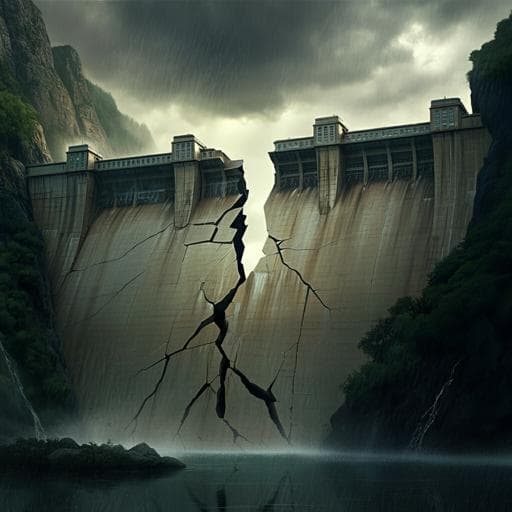
Earth Sciences
Increasing dam failure risk in the USA due to compound rainfall clusters as climate changes
J. Hwang and U. Lall
This research by Jeongwoo Hwang and Upmanu Lall explores alarming trends in rainfall patterns linked to 552 dam failures across the US since 2000, revealing that compound precipitation events are on the rise and pose serious risks to our aging infrastructure.
~3 min • Beginner • English
Introduction
Dam failures have been increasing in recent decades, raising concerns about aging infrastructure in the United States. The National Inventory of Dams lists over 92,000 dams (average age ~60 years), with approximately 25,000 classified as high or significant hazard; 74% of these are rated fair, poor, unsatisfactory, or not rated. Since 2000, 630 failures in the contiguous US have been reported due to hydrologic factors. Conventional design standards focus on spillway capacity for the inflow design flood (often PMF/PMP), typically event-based over 1–24 hours under extreme antecedent moisture. Yet recent failures (e.g., Oroville 2017; Michigan 2020) occurred under relatively moderate meteorological conditions, often following sequences of storms that increased antecedent soil moisture and filled reservoirs, with operators maintaining high storage for operational or regulatory reasons, leaving limited flood storage. These conditions fall below assumed design criteria that emphasize a single extreme storm event.
The study addresses three questions: (1) What primarily triggered recent hydrologic dam failures: sequences of high rainfall, a single extreme rainfall, or both? (2) How has the likelihood of these factors evolved across the CONUS? (3) What does this imply for changing dam failure risk relative to data available at design time? Given evidence that extreme precipitation frequency and clustering vary with climate variability and change, and concerns that current design standards may be insufficient, the paper provides a systematic, continental-scale analysis linking rainfall sequences to failure risk.
Literature Review
Prior research documents increases in intensity and frequency of extreme precipitation across large parts of the US, with projections for continued amplification under warming consistent with Clausius-Clapeyron. Studies also argue current hydrologic design standards are increasingly insufficient given observed increases in rainfall extremes. While much of the literature focuses on daily and sub-daily extremes, flood generation depends on antecedent conditions and event sequencing. Persistent atmospheric circulation regimes can produce recurrent storms that cluster in time, elevating flood peaks and volumes. Despite these insights, there has been no systematic continental-scale analysis of rainfall sequences preceding failures, partly due to complexities in modeling hydroclimate in tandem with reservoir operations and dam condition. This study fills that gap by jointly analyzing event rainfall and antecedent multi-day totals at failure sites and evaluating their changing likelihood over time.
Methodology
Data and sample: Using the ASDSO Dam Incident Database, the study examines 552 US dam incidents attributed to hydrologic factors during 2000–2021 (excluding snowmelt-related incidents due to limited snow data). These 552 incidents occurred on 128 distinct days. Construction year was available for 497 dams.
Precipitation data: Primary analyses use the ISIMIP3 20CRv3–ERA5 daily precipitation (0.5°) for 1901–2021, formed by combining ERA5 (1979–2019) with bias-adjusted 20CRv3 (1901–1978) using ISIMIP3BASD v2.5.1; averages of the four nearest grid cells, distance-weighted, represent each dam location. Trend confirmation uses NOAA CPC-CONUS gauge-based daily precipitation (1979–2021).
Event definitions: For each incident i, define A* as the maximum 1-day precipitation within k days prior to the incident date, and K* as the cumulative precipitation over the prior k days (k = 5 and 30 used; k = 10 produced similar results to k = 5; 30-day upper limit reflects typical soil moisture residence time). A and K denote, respectively, annual maxima of daily precipitation and of k-day totals ending on the A date.
Univariate modeling and non-stationarity: Annual maxima A are modeled with a Generalized Extreme Value (GEV) distribution; K with a 2-parameter Gamma (G2) distribution. Non-stationarity is accommodated via linear trends in the location and/or scale parameters for each marginal (shape held constant for GEV). Four model forms (no trend; trend in location; trend in scale; trend in both) are compared using BIC to select the best fit at each site. Parameters are estimated using R packages ismev (GEV) and gamlss (Gamma). Return periods for A* and K* are evaluated at the year of incident and, where available, at the year of construction.
Dependence and joint modeling: Stationarity of dependence between A and K is assessed by testing temporal trends in the correlation of their probability integral transforms u = F_A(A) and v = F_K(K) via a Mann–Kendall test; no significant trends are found, so a stationary dependence structure is assumed. Bivariate dependence is modeled using parametric copulas selected by BIC (R VineCopula). The joint exceedance probability p(A* > A, K* > K) is computed from the copula and marginals, yielding the joint return period T = 1/p. Uncertainties in return period estimates are provided in Supplemental materials.
Temporal comparison and trends: For the 497 dams with known construction years, exceedance probabilities/return periods for A*, K*, and joint (A*,K*) are compared between construction and incident years using at-site non-stationary models. Recent linear trends (1979–2021) in 10- and 100-year return levels of A, K5, K30, and joint combinations are computed from CPC-CONUS. Spatial overlays identify regions where large, high/significant-hazard dams coincide with increasing joint-event severity/frequency.
Exclusions and quality checks: Snowmelt-triggered incidents are excluded due to lack of long-term snow data necessary for severity assessment. Data quality and representativeness considerations include CPC quality control, interpolation bias assessments, and using multiple nearby grid points for reanalysis representation.
Key Findings
- For the 552 hydrologic dam failures (2000–2021), the event-day maximum 1-day rainfall (A*) was typically moderate: often with return periods under 10 years, with only a few cases reaching ~100–1,000 years. These are far smaller than PMP/PMF design criteria.
- Antecedent multi-day totals (K5* and K30*) had similar to slightly larger return periods than A* individually, but the joint occurrence (A*, K5*) or (A*, K30*) was frequently very rare (high return periods), indicating compound risk from rainfall clustering and wet antecedent conditions.
- Illustrative clusters: South Carolina (Oct 2015) saw >40 failures during persistent multi-day heavy rainfall plus high 1-day totals, producing extreme joint return periods; New Jersey/New York (Hurricane Irene, 2011) exhibited prolonged heavy rainfall ~15 days before the hurricane, yielding extreme (A*, K30*) joint events.
- Comparison between construction and incident times (497 dams with construction dates) shows no statistically significant nationwide change in exceedance probabilities for A*, K5*, K30*, or joint events; however, regional patterns exist (e.g., increasing A* probabilities in the Northeast with mean dam age ~98 years; decreasing K5*/K30* probabilities in parts of the South with mean age ~58 years). Spatial variability may mask national trends.
- Independent trend analysis using CPC-CONUS (1979–2021) confirms decadal variability and shows: while univariate trends in A, K5, and K30 are spatially patchy with isolated significant areas, there are widespread statistically significant increases in joint events combining 100-year A with 10-year K for k = 5 and 30 days.
- Many large dams (height > 12.2 m or storage > 1.23 million m³) classified as high or significant hazard are located within regions experiencing increased occurrence/severity of these joint events.
- The annual number of dam incidents displays a significant upward trend since 2000 (Mann–Kendall; Sen’s slope 1.57 incidents/year; p = 0.001).
Discussion
The analysis shows that recent hydrologic dam failures are more strongly associated with compound precipitation—moderately rare event-day rainfall coinciding with rare antecedent wetness—than with extreme single-day rainfall alone. This directly addresses the research questions, indicating that sequences of rainfall events (clustering) play a primary role in triggering overtopping by elevating antecedent soil moisture, increasing runoff, and filling reservoirs prior to the final event. Despite traditional design criteria aiming to withstand highly conservative inflow design floods, many recent failures occurred under conditions substantially more moderate than those criteria, highlighting a mismatch between design assumptions and the actual drivers of failure.
The increasing frequency and severity of joint rainfall events across much of the CONUS, together with aging infrastructure and limited flood storage due to operational constraints, elevate failure risk. Persistent atmospheric circulation regimes likely underpin the recurrent rainfall sequences implicated in failures, suggesting that sub-seasonal to interannual climate diagnostics and forecasts could be leveraged to anticipate elevated risk periods. However, assessing the concurrent operational risk (e.g., reservoir storage near capacity) remains difficult due to sparse data on inflows, outflows, storage, and dam condition, which constrains comprehensive risk attribution at continental scale.
Overall, the findings imply that dam safety evaluations and design standards should incorporate compound event statistics and antecedent conditions alongside operational states. Regional variations in trends and dependencies further suggest the need for spatially targeted risk management and adaptation strategies.
Conclusion
This study provides the first continental-scale assessment linking rainfall sequences to hydrologic dam failures across the US. It demonstrates that compound precipitation—moderately rare 1-day rainfall combined with rare wet antecedent conditions—is a common driver of recent failures, while isolated 1-day extremes alone often were not. The probability of such joint events has increased across large portions of the CONUS, and many high/significant-hazard, large dams are situated in these regions.
Implications include the need to revise dam design and safety standards to account for compound precipitation risks, watershed memory, and reservoir operations. Future work should: (1) develop portfolio-scale risk assessments integrating climate, fragility, and operational factors; (2) improve predictability and early warning by exploiting persistent atmospheric circulation diagnostics; (3) incorporate detailed reservoir operations and storage data to evaluate dynamic risk; and (4) extend analyses to include snowmelt-related events where suitable data become available.
Limitations
- Incident data completeness: The ASDSO Dam Incident Database may not include all historical incidents.
- Construction year availability: Only 497 of 552 failures had construction dates, limiting temporal comparisons.
- Exclusion of snowmelt: Snow-driven incidents were excluded due to lack of long-term snow data for severity assessment, reducing scope in snow-dominated regions.
- Operations and condition data: Limited availability of reservoir inflow/outflow/storage data and widespread unrated dam conditions impede attribution of overtopping risk to operational practices or structural state.
- Gridded precipitation representation: Use of 0.5° reanalysis and gridded gauge data may introduce spatial representation errors at specific dam sites.
- Modeling assumptions: Non-stationarity handled via linear trends in marginal parameters; dependence assumed stationary (based on tests). Choice of distributions and copulas selected via BIC may not capture all tail behaviors. Uncertainty remains in estimated return periods (documented in Supplemental materials).
Related Publications
Explore these studies to deepen your understanding of the subject.







